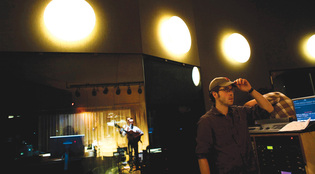 loading
loading
Arts & CultureSwing spaceChristopher Arnott is a freelance arts writer in New Haven.  Christopher CapozzielloNick Lloyd ’97, ’01MA, listens in as the Julian Lage Group performs its jazz/classical act last March. Lloyd's New Haven recording studio and club, Firehouse 12, has become a premier venue for outré jazz performers. View full image
When Nick Lloyd ’97, ’01MA, went looking to build a haven for new jazz, he improvised. Extravagantly renovating a dilapidated firehouse building on a sketchy block of New Haven’s Ninth Square, the young recording engineer set his ear on free jazz and post-bop sounds from the fringe of the fringe. He installed a state-of-the-art recording studio, which doubles as a “listening room” for intimate concerts, and began booking an ever-changing roster of musicians, attracting the best by paying the same fees as big-city clubs. He accepted the need for a bar—but put it downstairs, separate from the soundproofed studio.
In an age when much non-mainstream music is now traded digitally and seldom gets printed and packaged, Lloyd launched his own CD label and made the first release an imposing ten-disc set. And at a time when many recording studios are closing shop, Lloyd is expanding into another building. Having several revenue streams—from concerts, recordings, and the bar—helped reduce the financial pressure on the studio, he says. Lloyd calls his shrine to outré jazz artistry Firehouse 12. Its dramatic renovation, by Gray Organschi Architects (founded by Yale alumni), involved removing half the firehouse floor and installing a cement staircase. Lloyd and his wife, painter Megan Craig ’97, live in an apartment upstairs with their seven-month-old daughter, Cora. The studio opened in 2005 and gained an immediate international reputation: the jazz elite recognized it as the kind of place they might play in Europe but could seldom find in the United States. Lloyd cultivated the sort of artists whose exacting standards and idiosyncratic sonic sensibilities make them unsung and underappreciated elsewhere. “The music we do is marginalized, so there’s a tendency to marginalize ourselves even further,” explains Michaël Attias, a New York–based composer and saxophonist who has performed live at Firehouse 12 with his own quintet and played as a sideman on John Hebert’s CD Byzantine Monkey, which was released on the studio’s record label. “Firehouse 12 is representing this music with a very high level of quality that doesn’t usually happen. Beauty is so much more subversive.” “I think it’s the best jazz venue in America,” declares improvisational guitarist Joe Morris, a Connecticut resident who teaches at the elite New England Conservatory. Firehouse 12, Morris says, “is designed to be acoustically true to the kind of music we make, unlike some places that need to put the music through large PA systems.” The next phase for Firehouse will start its hip vibe going on nearby Union Street. A second recording studio is being developed in the warehouse where Lloyd has been renting storage space ever since 2007, when the first release from his record label was delivered. The new studio will be less expensive to rent than the more polished Crown Street studio, Lloyd says, “but it is also a dramatically different acoustic environment. I could record an orchestra in there—it’s humongous.” The new space might even be a place where Lloyd himself might feel comfortable playing. Firehouse 12 is a monument to his jazz tastes, but Lloyd also has unassailable rock cred: he recorded and co-produced the first two albums by the National, one of the major indie-rock successes of recent years. He still plays with a local “outlaw country” band, the Wagon Riders. “Most of the bands I play in—we wouldn’t play” at Firehouse 12, Lloyd says, smiling at the irony. “Musicians have to be comfortable where they play. Rock bands are more about the big gesture.”
The comment period has expired.
|
|